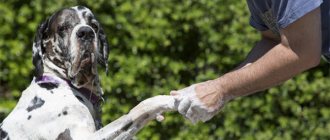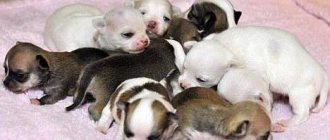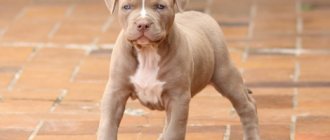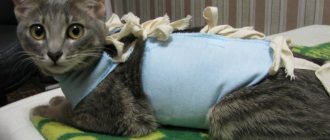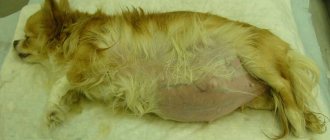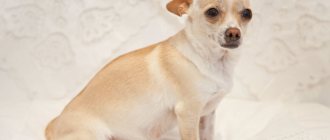Physiology of a healthy dog
In order to know whether to feed your dog before or after a walk, you need to pay attention to physiology. The food a dog eats first goes into his stomach. The next stage of movement is the small intestine and beyond.
It is pointless to describe the entire process. After all, this is a complex task, for which the animal’s body needs to spend a lot of energy.
While processing food, the dog spends more energy than when it is simply calm. In this case, the heart and blood vessels are actively involved.
Digestion process in dogs
Food is absorbed and digested differently in dogs than in humans. Food is coated with saliva and easily passes through the larynx, sometimes pieces are not even chewed. Dogs lack digestive enzymes, so digestion begins only when food enters the animal's stomach, and not into the mouth (as in humans). Final absorption occurs in the intestines. And since a dog’s digestive tract is 2 and sometimes 3 times smaller than that of a human, it experiences greater stress.
Since a dog's stomach does not have supporting muscles and there are no enzymes in the saliva, the pet needs long pauses between feedings. Your pet will need several hours of rest after a hearty meal. Feeding him too often is harmful, and any activity after lunch will be perceived negatively by him.
What happens during a walk?
While walking, an ordinary, healthy dog spends a lot of energy. Her muscles are doing intense work. Again, it is the blood vessels and heart that are actively involved.
Therefore, when deciding whether to walk your dog before or after eating, you need to understand that after feeding, the heart will receive 2 times more load than at rest. Since the cardiovascular system will work on 2 fronts: digesting food and, accordingly, the walk itself.
But the heart cannot constantly withstand such heavy loads. Therefore, over time, it begins to perform its functions worse in the area where it is easier to do this - in digestion. An insufficient rate of digestion will certainly lead to complications in the dog’s health - just give it time.
So, when should you walk your dog before or after meals? Veterinarians unanimously declare: only up to. Otherwise, the dog’s overloaded heart and blood vessels will significantly affect the deterioration of its health.
How to create a daily routine
In most cases, a domestic dog is fed twice a day, in equal portions in the morning and evening. The food used in feeding should not be too varied, but at the same time it must contain everything the dog’s body needs. Since a dog's digestive system selects different enzymes to digest different foods, it is advisable to alternate between them. For example, it is better to give meat rich in animal proteins in the evening, and leave carbohydrate porridge with vegetables for morning meals. This will promote proper digestive processes and eliminate health problems for the dog.
If the owner feeds an adult animal once a day, then to develop cleanliness in him, you can adhere to the following feeding and walking plan:
- walking in the morning - 7:00;
- daytime walking - 14:00;
- feeding with daily allowance of food - 18:00;
- evening walk - 21:30.
At night, all processes inside the dog’s body are inhibited, so a sleepy animal will not ask to go to the toilet until the morning. True, this is only if the pet has already been taken for a walk after the evening meal.
Did you know? The intelligence of many adult dogs is comparable to the abilities of three-year-old human children. Animals are able to recognize up to 300 words, count to 5, and even solve basic math problems.
What about the toilet?
Why do some owners prefer to take a walk with their dogs before feeding? They are guided by their own logic, which is quite normal at first glance: if you go for a walk with a hungry dog, it simply will not have anything to go to the toilet with and after eating it will have to be taken for a walk again.
However, one simple physiological fact destroys this entire logical chain. The fact is that digestion of food takes a long time. The whole process can take not just a few hours, but several days. How long the digestion process takes depends on the general condition of the animal, as well as what food it ate.
It turns out that to answer the question, the dog needs to be walked before or after meals, definitely before. Anyway, all the food eaten before the walk will not be digested.
We immediately answer another important question - if you feed the dog after a walk, will it be able to calmly wait until the next walk? Yes, he certainly can. There is no doubt about it. An adult, healthy dog can tolerate it calmly.
When to feed, before or after walking
During the walking process, it is rare that an animal will agree to walk calmly next to its owner, because there are so many interesting and unusual things in the world. Once outside, puppies and young dogs prefer to run, play and frolic with their relatives, which is not always convenient on a full stomach. Whether it is worth feeding the animal shortly before a walk - each owner must determine for himself, taking into account all the advantages and disadvantages of such a decision, always based on the age of the pet.
Puppy
Puppies up to five months of age are taken out into the yard 5-6 times a day, each time after a long sleep or shortly after eating food. Little kittens are not yet able to restrain the natural urge to urinate or defecate, so if there is no temporary litter box at home, the owners have to take them outside. Usually we are talking about a short walk, so 20-30 minutes after a meal you can take the puppy out for a walk for 15-20 minutes. However, the most suitable time is always calculated individually, based on long-term observations of the kitten: some babies run to the toilet almost immediately after eating, while others may not ask for a whole hour, preferring to sleep first. Why this happens is difficult to guess, but it is known for sure that temperament and breed characteristics play a significant role in this.
When teaching older dogs basic commands, you should not feed them before the next walk. During training, a special dog treat or dry food pellets are considered good motivation, but they can interest the animal only if it has not had time to eat well before walking. In such cases, it is better to feed young pets after a full walk, when they need to replenish expended energy reserves.
Adult dog
After 6-7 months of life, a physically healthy dog is fed no more than three times a day, allowing at least 3-4 hours of rest between meals. A well-mannered pet can go without a toilet for about this long, so you shouldn’t drag the animal outside soon after a meal. Of course, one cannot ignore the individual characteristics of a pet, and if a particular animal has a fast metabolism, you can reconsider the walking plan, reducing the rest time after eating or, conversely, adhering to more frequent feeding, giving the animal small portions of food.
Important! Active games on a full stomach are prohibited.
Jumping, running and wriggling during games, the dog may well develop a volvulus, which often leads to death.
How often should you give your animal food?
We have determined whether to walk the dog before or after meals. Now let's talk about how often you need to feed the animal. It all depends on how old the dog is (data is given for 1 day):
- up to 2 months – 5 times;
- up to 4 months – 4 times;
- up to 8 months – 3 times;
- more than 8 months – 2 times.
There is no need to try to overfeed the animal. It is enough for the dog to eat the food offered to the end. If a dog does not finish eating, it means that he is given extra food.
Walking dogs at different ages
The duration and number of daily walks depends entirely on the age of the dog.
It is better to walk an adult dog three to four times a day. Many owners often do not have enough time for walks and there is simply no one to walk the dog. In these cases, the animal can be walked in the morning and evening and this will not worsen its physical condition at all. For adult dogs, the minimum morning walk should be about 30 minutes just to go to the toilet, but the evening walk should be longer. It is better, of course, to go out into nature for a few hours on weekends and in good weather, and be sure to vaccinate your pet against parasites.
You need to walk puppies more often, every two to three hours. The more often a person walks with his little pet, the faster he will teach him to go to the toilet outside and ask for a walk at the right time. After the dog is six months old, walks can be slightly shortened, but their duration should increase so that the dog can properly frolic. If you walk the puppy longer, then at home he will behave calmer, damage the furniture less, and run around the house less.
In the summer, it is better to postpone walking your pet until the early morning and evening. This also applies to puppies, especially if they have dark coat color. In the cold season, on the contrary, it is worth shifting your walk to a warmer time of the day, not in the morning or late in the evening. In winter, it is recommended to walk with the animal for a short time; if possible, it is worth purchasing clothes for it.
How to build a walking regimen most effectively?
The schedule of walks and their duration depend on a number of important factors, the main one of which is the owner’s availability of free time. Most modern owners structure their daily routine so that they can walk with their four-legged friend in the morning before work/school and in the evening. If you have more free time, you can increase the duration and frequency of walks.
Features of walking depend on:
- The age of the animal. The puppy should be outside as often as possible to get used to relieving itself outside the house. It is then that he remembers where to go to the toilet and gets used to asking. However, at first you can leave the house for a short period of time from 15 to 30 minutes. Starting from 6 months, you can gradually reduce the number of exits and reduce them to 2, but at the same time increasing the duration. The same process occurs in parallel with nutrition. The puppy, who previously ate up to 6 times a day, is gradually transferred to twice a day feeding. If you do everything synchronously, then the dog’s internal rhythms will coincide, and he will get used to enduring until the required time.
- Health and training. Animals on a special regime completely change their daily routine. For example, during a period of quarantine after illness or surgery, the dog is either not taken outside at all or released for a very short period of time. And if the animal undergoes canine training or is actively involved in sports, then much more time is spent outside the home. Depending on this, nutrition may change. A sick animal often feeds much more often, but in small portions, but dogs leading a hyperactive lifestyle can be transferred to one-time feeding.
- The time of year also makes its own adjustments. If in the warm months, when the sun is very active, veterinarians and breeders advise walking early in the morning and late in the evening so that the dog does not overheat and lose its color, if it has dark fur, then with the onset of winter and cold weather it is better to move it a little so that walking coincided with the warmer part of the day and took less time.
Build a feeding and walking schedule based on your own daily routine and never break it, because by giving in to your mood, you throw off your pet’s internal clock and deprive him of confidence in the future. This can lead to unpleasant consequences both physically and psychologically.

